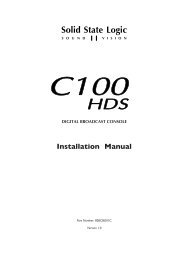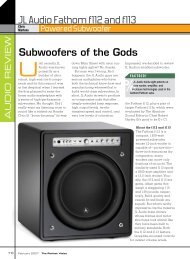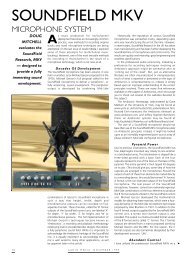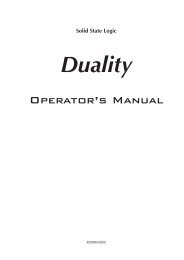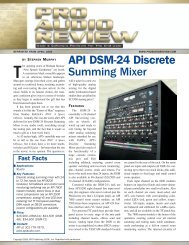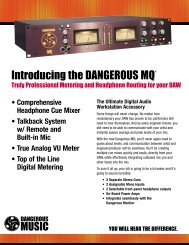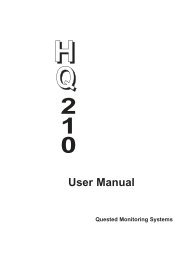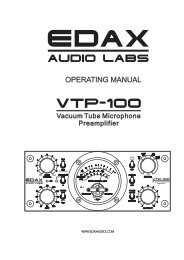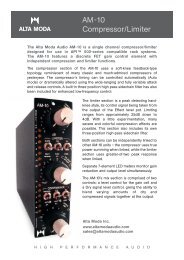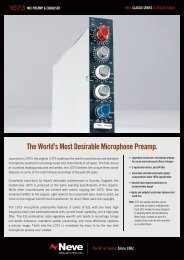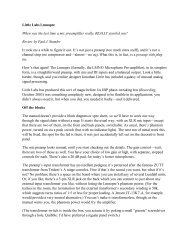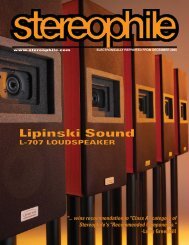Universal Audio 6176 Tube channel strip - Mastering Mansion
Universal Audio 6176 Tube channel strip - Mastering Mansion
Universal Audio 6176 Tube channel strip - Mastering Mansion
Create successful ePaper yourself
Turn your PDF publications into a flip-book with our unique Google optimized e-Paper software.
IN REVIEWOriginally printed in March 2003 issue of EQ. Reprinted with the permission of the Publishers of EQ. Copyright 2003CMP Information, Inc., a CMP Information company. All rights reserved. EQ is a Music Player Network publication,2800 Campus Dr., San Mateo, CA 94403 (650) 513-4300. Subscribe at www.musicplayer.com.By Mitch Gallagher, mgallagher@musicplayer.com<strong>Universal</strong> <strong>Audio</strong> <strong>6176</strong> <strong>Tube</strong> <strong>channel</strong> <strong>strip</strong>The whole isgreater thanthe sum of theparts<strong>Universal</strong> <strong>Audio</strong> has made a big splash with their1176LN reissue limiters. Likewise, the companyhas stirred up the preamp world with a reissue ofthe classic 610 preamp, originally part of the’60s-era console at United Recording in WestHollywood (now Oceanway). Both products havehad positive acceptance in the modern recordingworld, and are in wide use. Now UA has packagedthese two vintage units into one package,the <strong>6176</strong>, which comprises a single-<strong>channel</strong>610 tube mic preamp and an 1176 limiter in one2-rackspace chassis.The two “sides” of the <strong>6176</strong> can be usedtogether in a “<strong>channel</strong> <strong>strip</strong>” arrangement, wherethe preamp output feeds the input of the limiter,or the preamp and the limiter can be usedentirely independently as separate units. To thisend, there are separate inputs and outputs onthe back panel for each section. The preamphas both line and mic level XLR inputs, as wellas an XLR line level output. Likewise, the 1176section has an XLR input and and an XLR output.The input impedance of the 1176 sectioncan be changed from 15,000 ohms to 600 ohmsusing a back-panel Input Loading switch.Depending on the gear you’re interfacing to the1176, you may find that the tone is a bit brighterusing the 15k position.Around front, the faceplate is divided into twosections. The 610 tube preamp controls are onthe left; all the controls from the 610 and 2-610stand-alone preamps are included: a steppedgain control (–10, –5, 0, +5, +10 dB), an impedance/inputselect control (500 and 2k mic, line,47k and 2.2m instrument level), a large outputlevel knob, and a two-band EQ. The high EQ canoperate at 4.5k, 7k, or 10k Hz with a range of ±9dB, while the low EQ can operate at 70, 100, or200 Hz, with a ±9 dB boost/cut range. There’s nodedicated EQ bypass button, but the EQ boost/cutcontrols are rotary switches with a “0” position thateffectively bypasses the circuit. Rounding out thepreamp controls are a polarity switch, a 1/4-inchinstrument input, and something not found on theoriginal 610 models, a 15 dB pad switch.DIGIDESIGN DIGI 002MANUFACTURER: <strong>Universal</strong> <strong>Audio</strong>, P.O. Box 3818, Santa Cruz, CA95063. Tel: 831-466-3737. Web: www.uaudio.com.SUMMARY: Combining two high-end components in one unit providesgreat flexibility and power in a convenient, easy-to-use package.STRENGTHS: Preamp and compressor can be used independently ortogether. Line, instrument, and mic-level inputs. Two units mayinterconnect for stereo operation. Includes all the features and soundquality that made the originals so cool. Pad switch for preamp (notincluded on the original). Input loading switch for compressor.LIMITATIONS: No 1/4-inch line-level connections.PRICE: $2,495On the right side of the front panel are thecontrols for the 1176 section. As with the preamp,these duplicate those found on a stand-alone1176, although the form fact is slightly different.There are knobs for attack and release times,input and output levels, and a seven-positionrotary switch (instead of push button switches)for setting the compression ratio. In addition tobypass, this switch offers 4:1, 8:1, 12:1, and 20:1ratios. There’s also a 1:1 setting that passes thesignal through the limiter with no gain reduction —for adding “color” without compression, according tothe manual — and a final switch position that enablesthe “all four buttons pushed at once” trick from theoriginal. Above the ratio control is a meter functionswitch for choosing among preamp level, gainreduction, and compressor output being displayedon the front-panel mechanical VU meter.In the center of the front panel are the powerswitch and indicator, 48-volt phantom powerswitch, and a Join/Split switch for choosingwhether the two sections of the <strong>6176</strong> operatetogether as a chain or as independent units. Thislast item is convenient; I ended up leaving boththe preamp and limiter sections physically wiredup all the time, and was able to use themtogether and separately as the task required bysimply flipping the switch.IN USEThe <strong>6176</strong> is quite easy to use — the front panelis clearly laid out, and all the control choicesmake sense — but this doesn’t prevent the unitfrom offering a ton of flexibility. Aside from theobvious choice of whether or not you’re goingto use both the preamp and the limiter on agiven track, and whether or not you’re going toapply EQ to the high, low, or both bands,you’re given other options. One example: the90 I MARCH2003 I EQ
IN REVIEWpreamp impedance setting may or maynot make a significant difference in thetone of the mic you’re working with.With a Soundelux E47, for example,there was a noticeable sonic differencebetween the two settings; I preferredthe 500 ohm setting when trackingmy vocals.But as far as the preamp section isconcerned, the most tonal flexibility isprovided by the way the gain controlsare set up. It works almost like a guitaramp: If you run the Gain setting low(say, –10) and set the Level controlhigh (above 7 or so), you’ll get a crystalclear, transparent tone. But turn up theGain control to +5 or +10, and turndown the Level control, and the preampgets fatter, warmer, and almost fuzzy(in a good way). You can spend a lot ofhours futzing with the gain controls asyou’re trying out mics and impedancesettings on a sound source; all theresults that you get will be good (as faras the sound of the <strong>6176</strong> anyway!).It’s up to you to sort through them andchoose which settings are best foryour recording.But having this flexibility is great.For fingerpicked acoustic guitartracks and other delicate sources,you can dial in a clean, dynamic,round tone, while on crunchy orscreaming guitars, you can punchthings up with additional fatness and“texture.” Similarly on vocals, a cleantransparent sound suits certain stylesand singers, while cranking things upworks wonders to fatten up and roundout a nu-metal screamer. Combinethis with the ability to quickly drop afull-featured 1176 compressor intoyour signal path with the flip of aswitch, and you’ve got one extremelypowerful, flexible unit.But that’s not all this unit can do.Don’t forget that you can use the1176 section separately from thepreamp section. And there’s thatfront-panel hi-Z input that can beused for DI connection of a guitar orbass to the preamp — this soundsevery bit as good as using manystand-alone DI boxes, and has theoption of switchable impedance.While this made a subtle differencewith some of my guitars (a Les Pauland a Strat equipped with activeEMG pickups), the difference wasstartling with my Tele, which isequipped with “standard” single-coilpickups. The difference was evenmore dramatic with the under-saddlepickup in an acoustic guitar.JOINIn the time I’ve had to use the <strong>6176</strong>,I’ve become quite enamored of it. Theunit is tremendously flexible, bothfunctionally and tonally. I never founda source where I couldn’t dial upexactly the preamp sound that I wanted.Throwing a top-end compressorinto the mix and a flexible DI inputmakes this one versatile and powerfulpackage.To sum it up: The preamp soundsawesome, and is extremely flexibletonally. The EQ is useful for shapingyour signals. The 1176 limiter sectionprovides sought-after compressionand limiting characteristics. The preand limiter can be used together as a<strong>channel</strong> <strong>strip</strong> or as totally independentunits. And there’s nice extras, such asthe DI. With the <strong>6176</strong>, <strong>Universal</strong> <strong>Audio</strong>has created a box where the whole isgreater than the sum of the parts, andhas done it at a reasonable price. All inall, an outstanding package.



